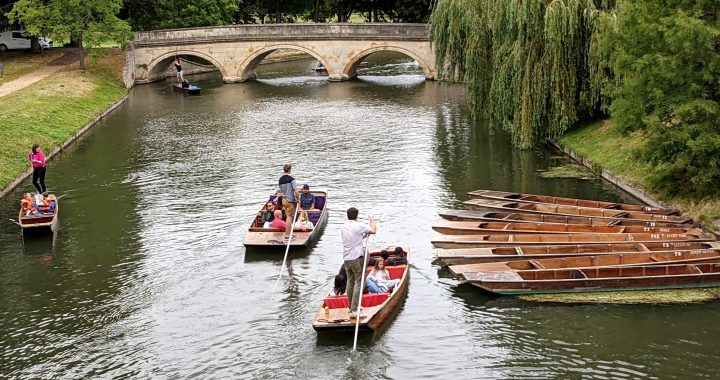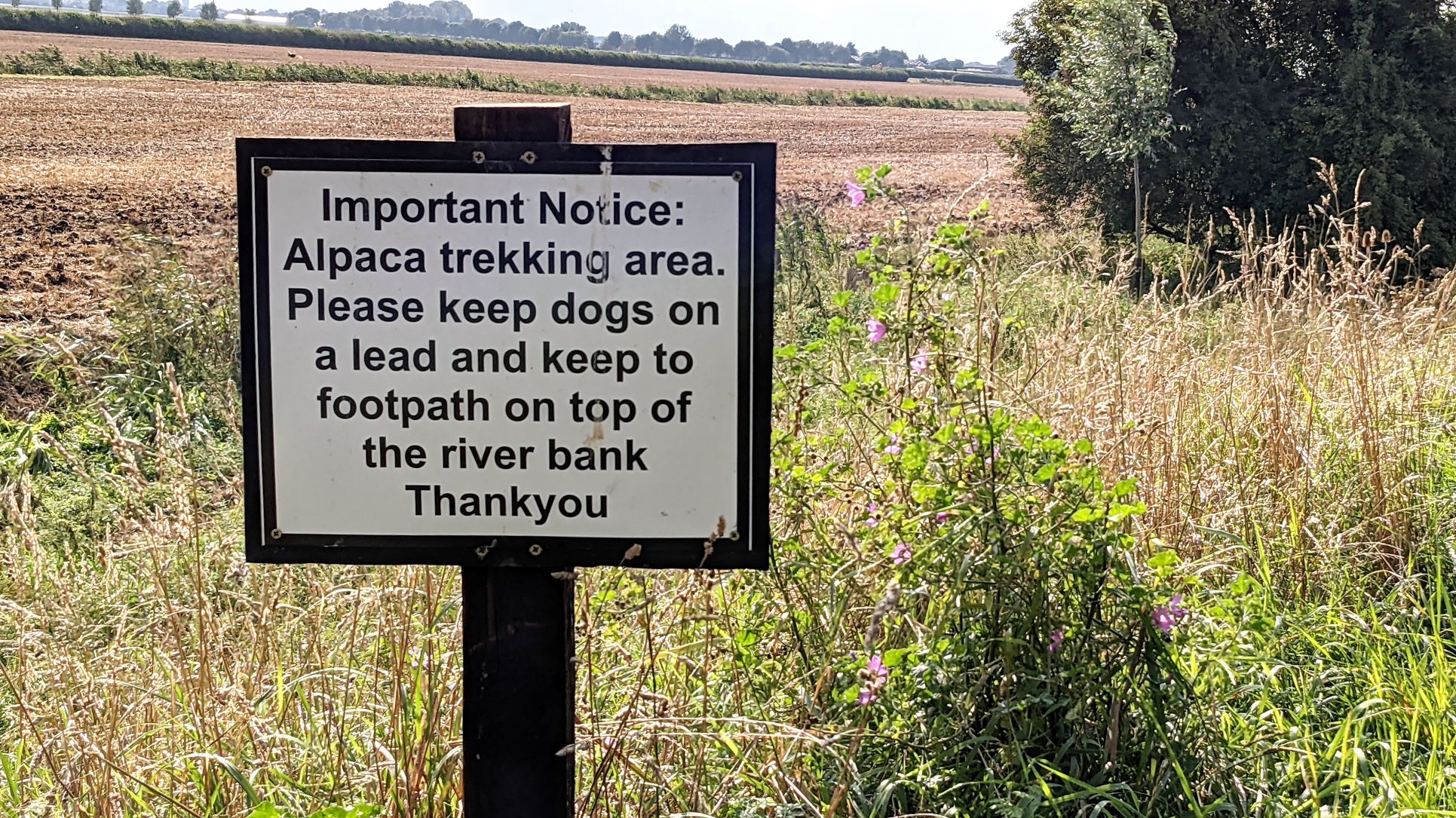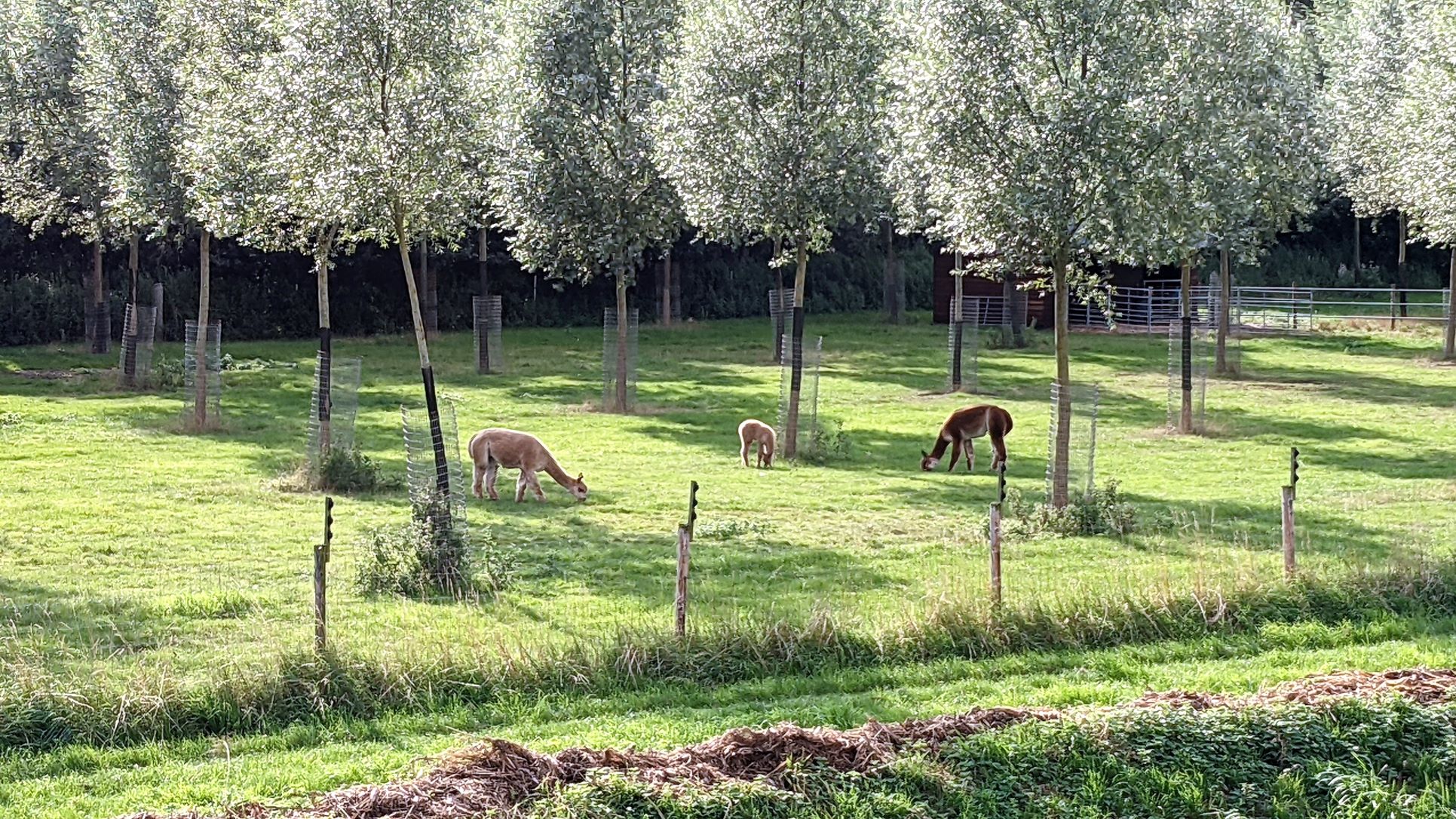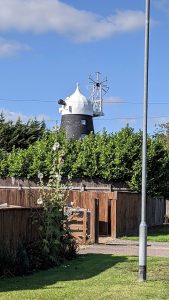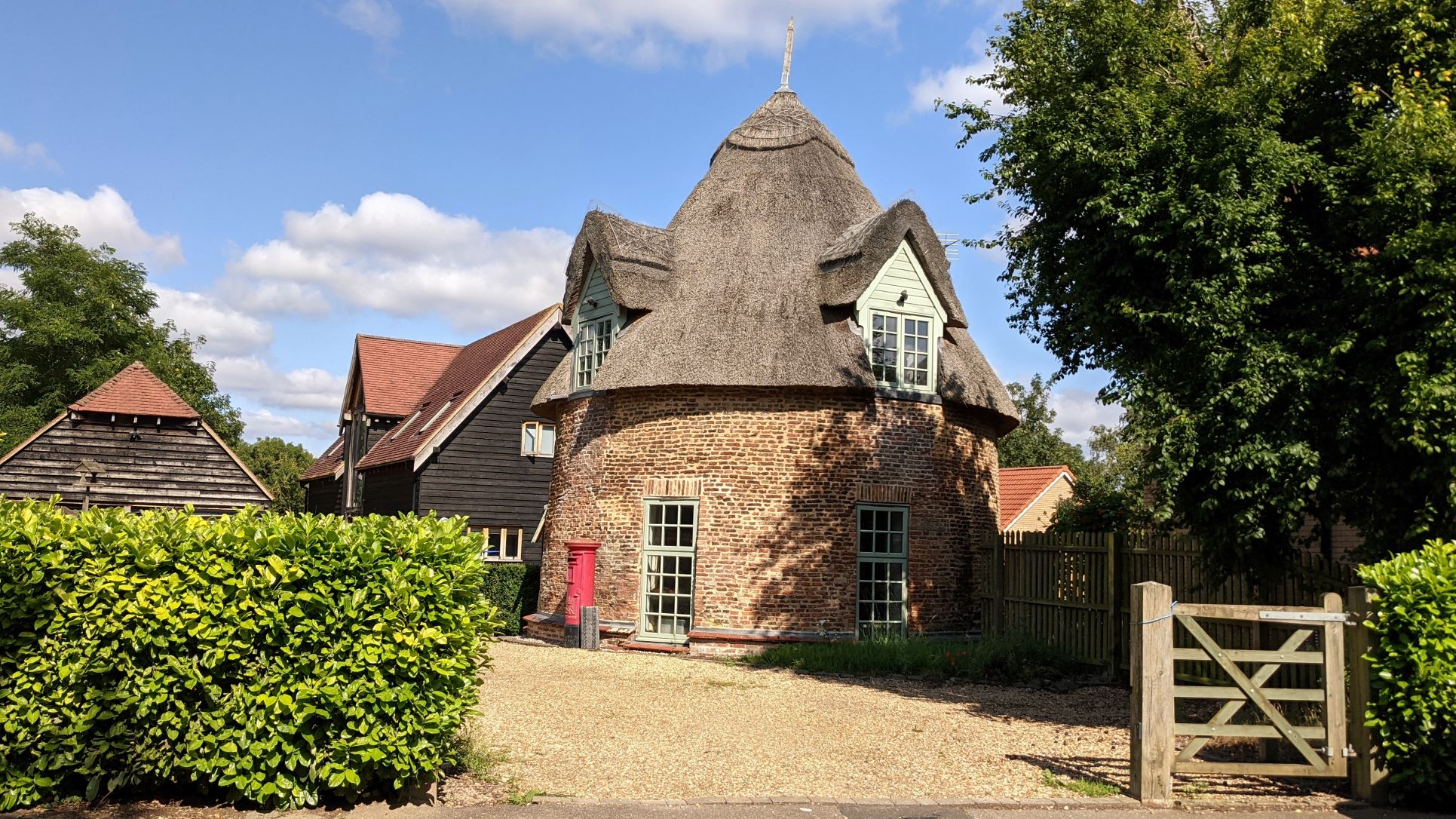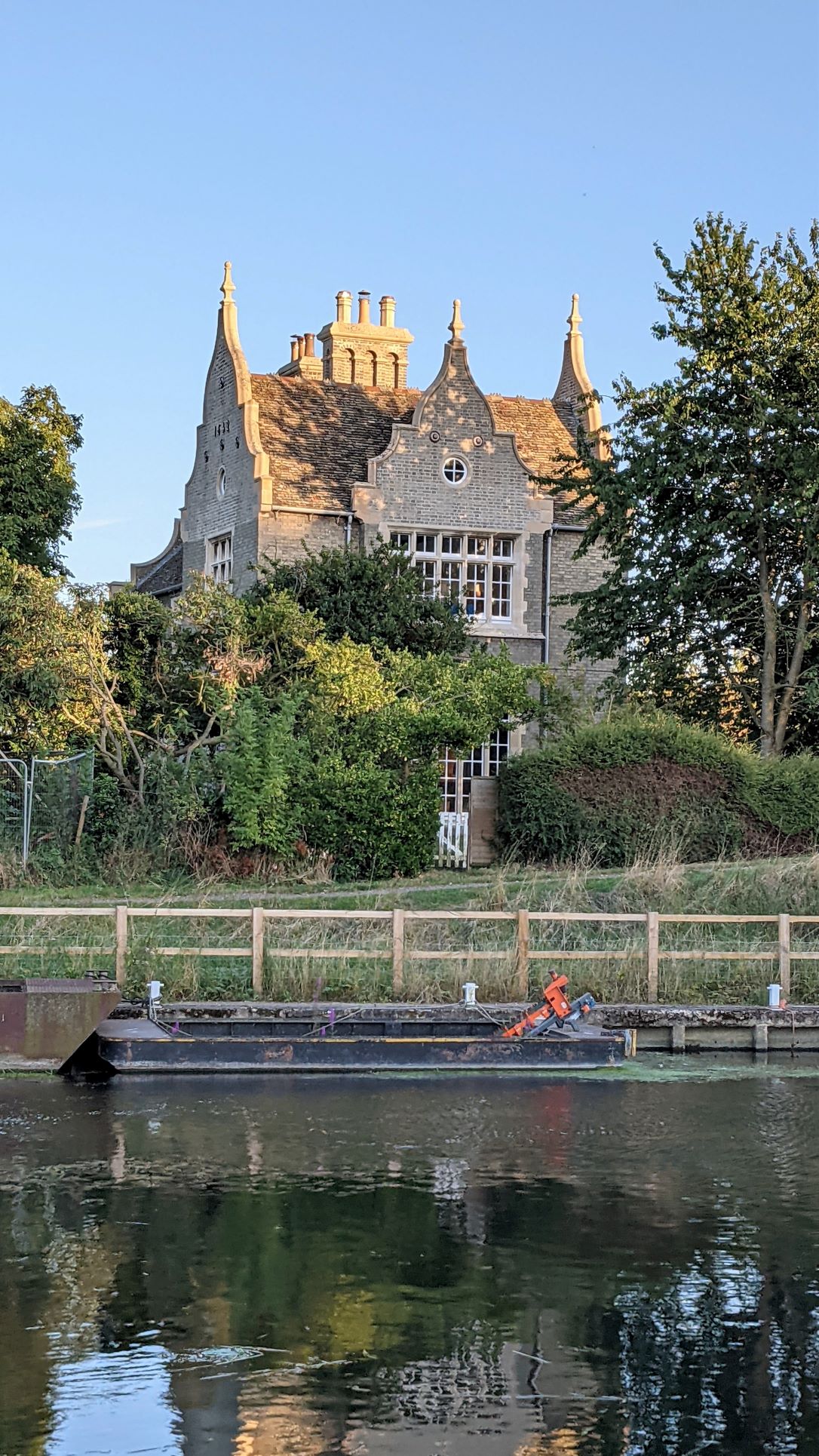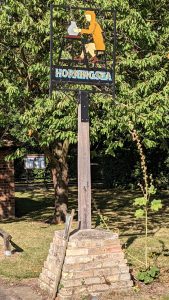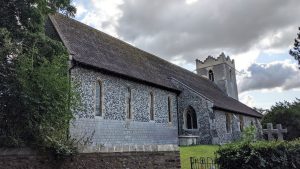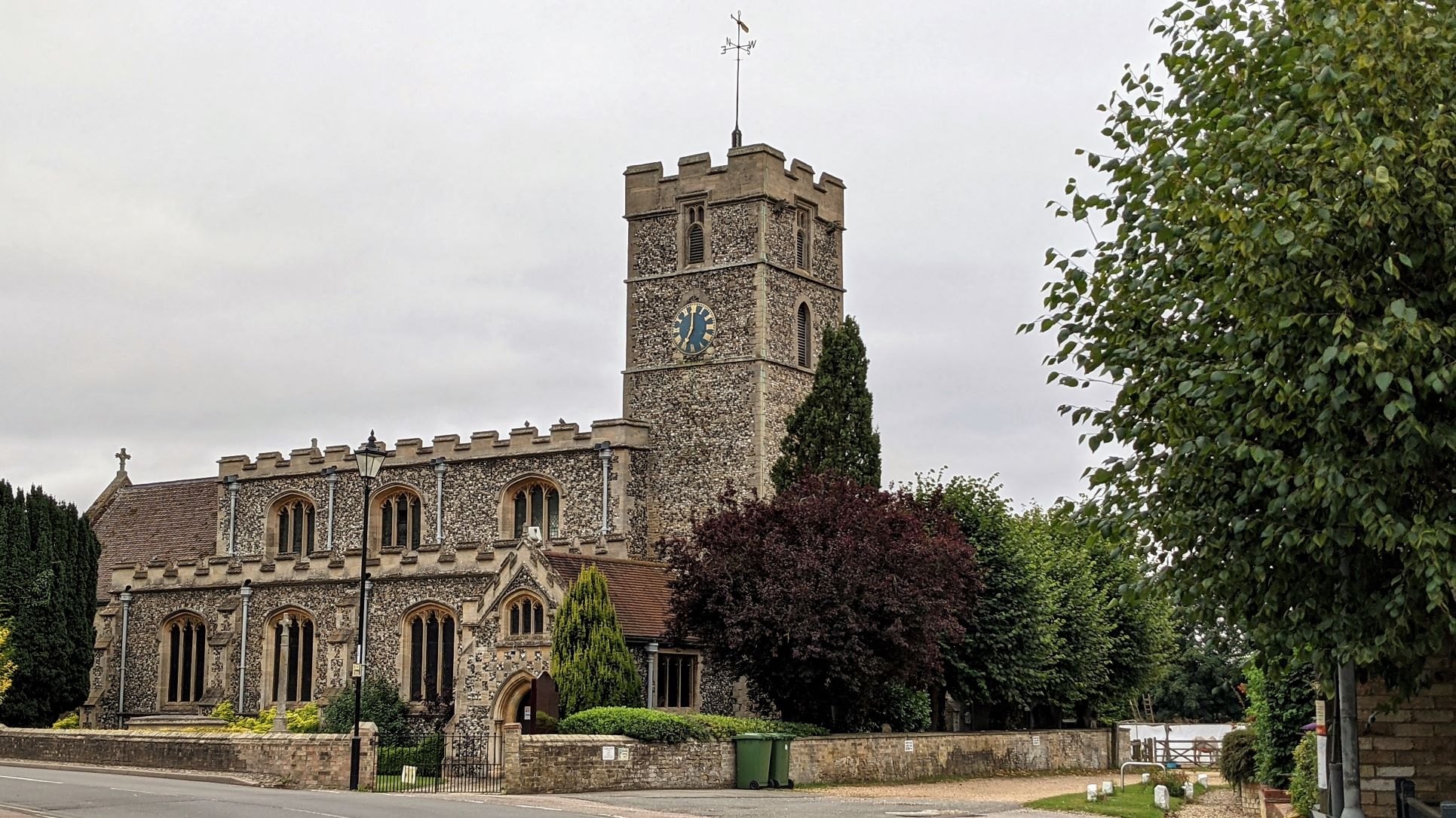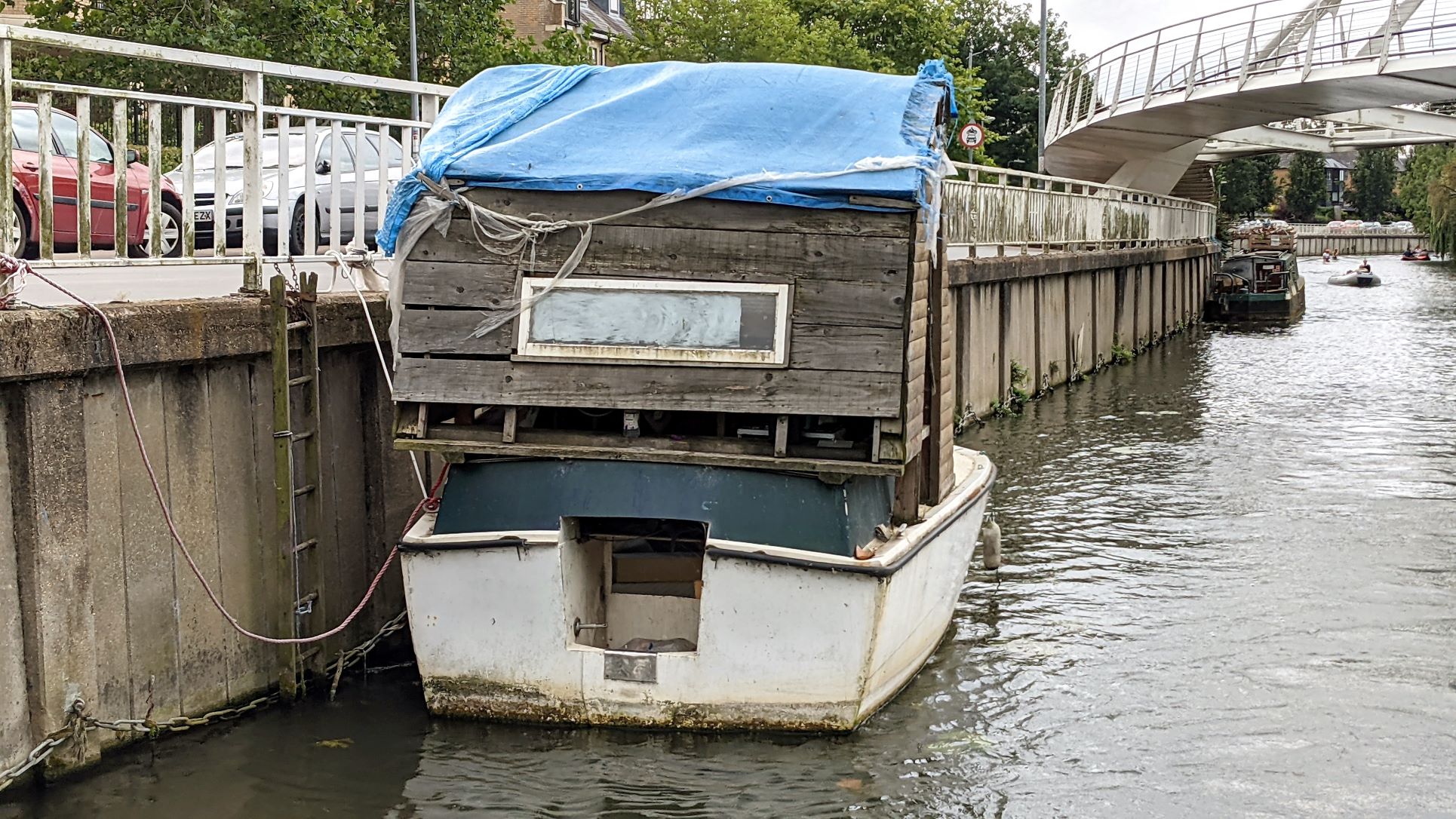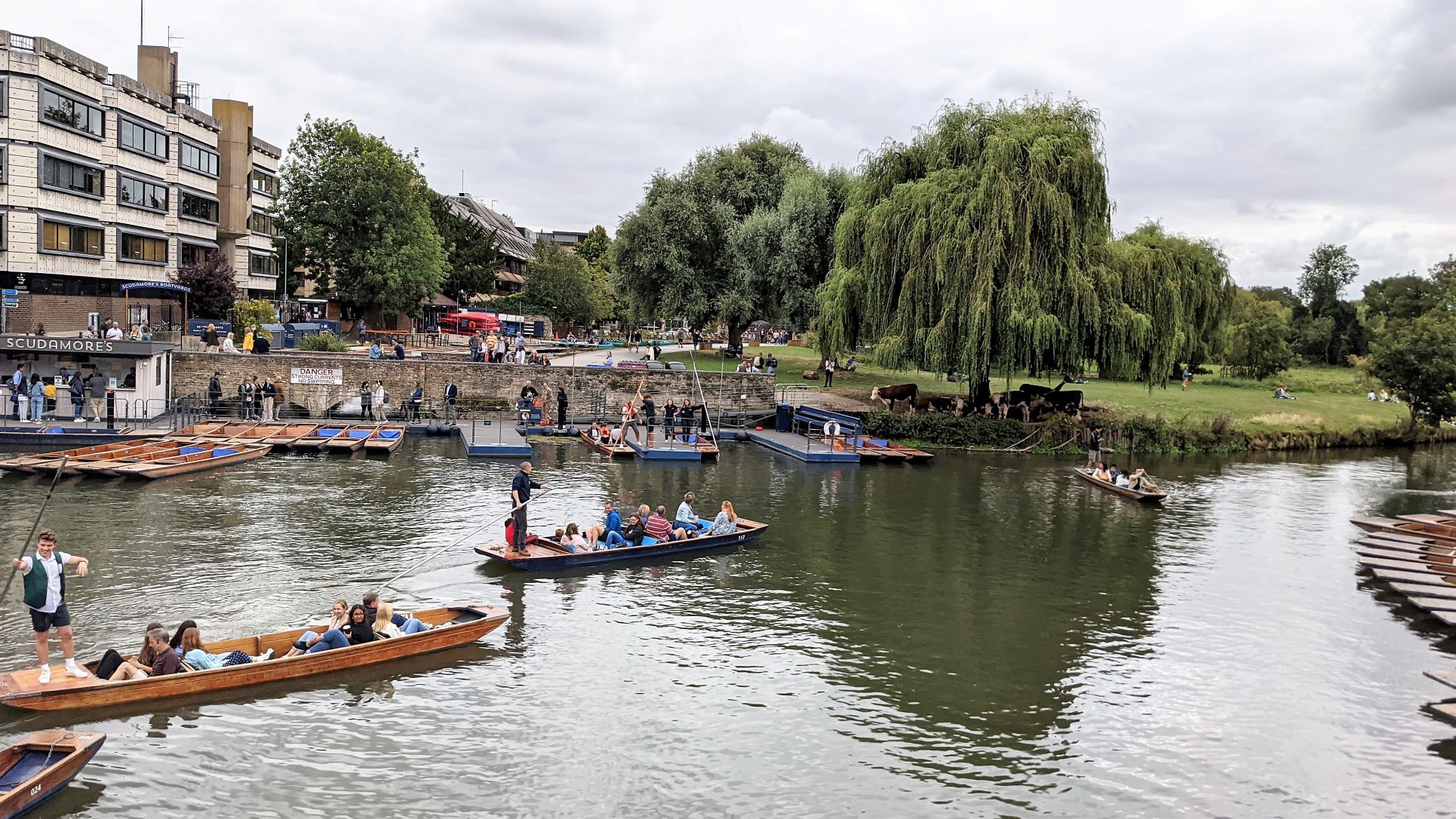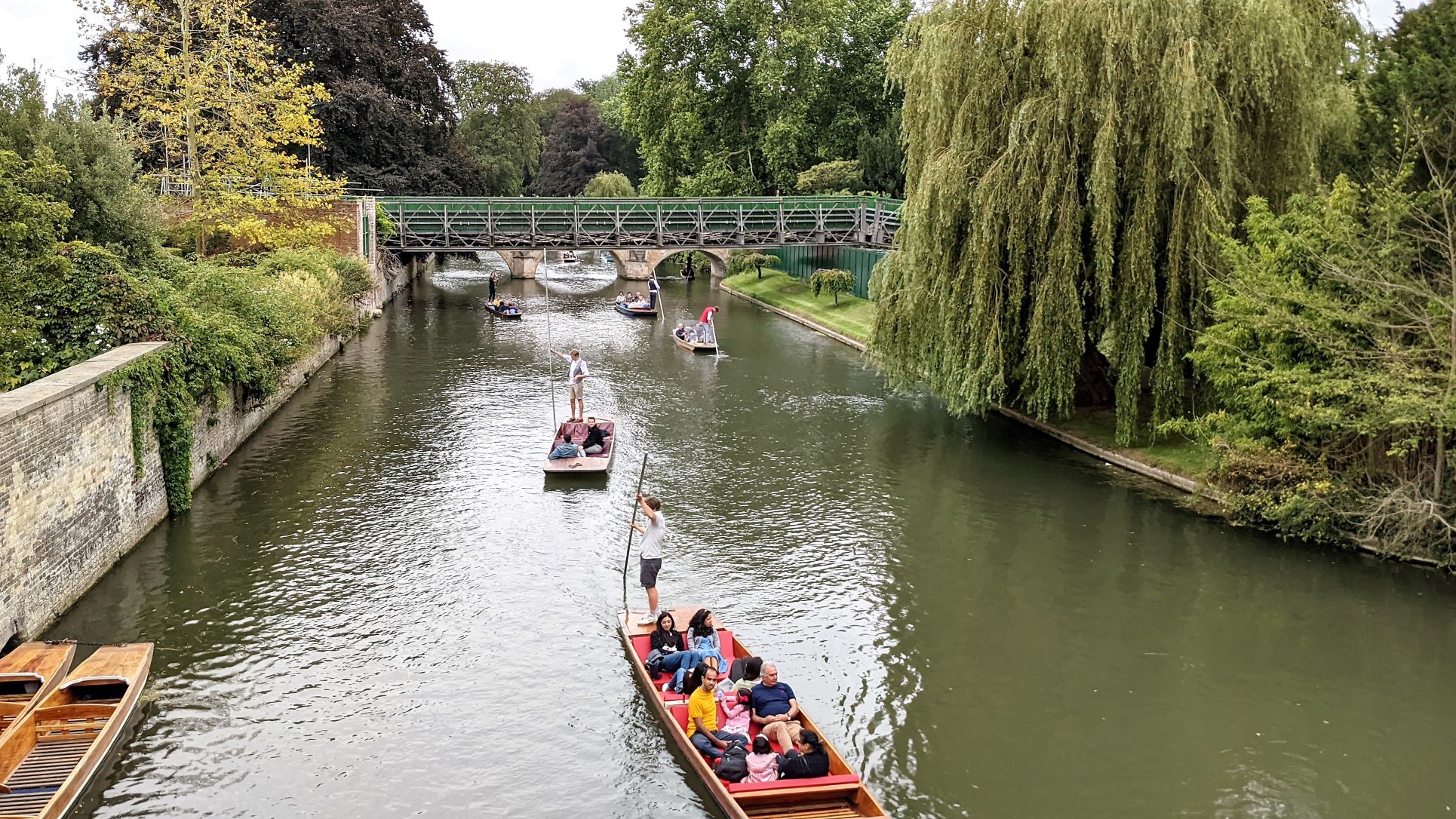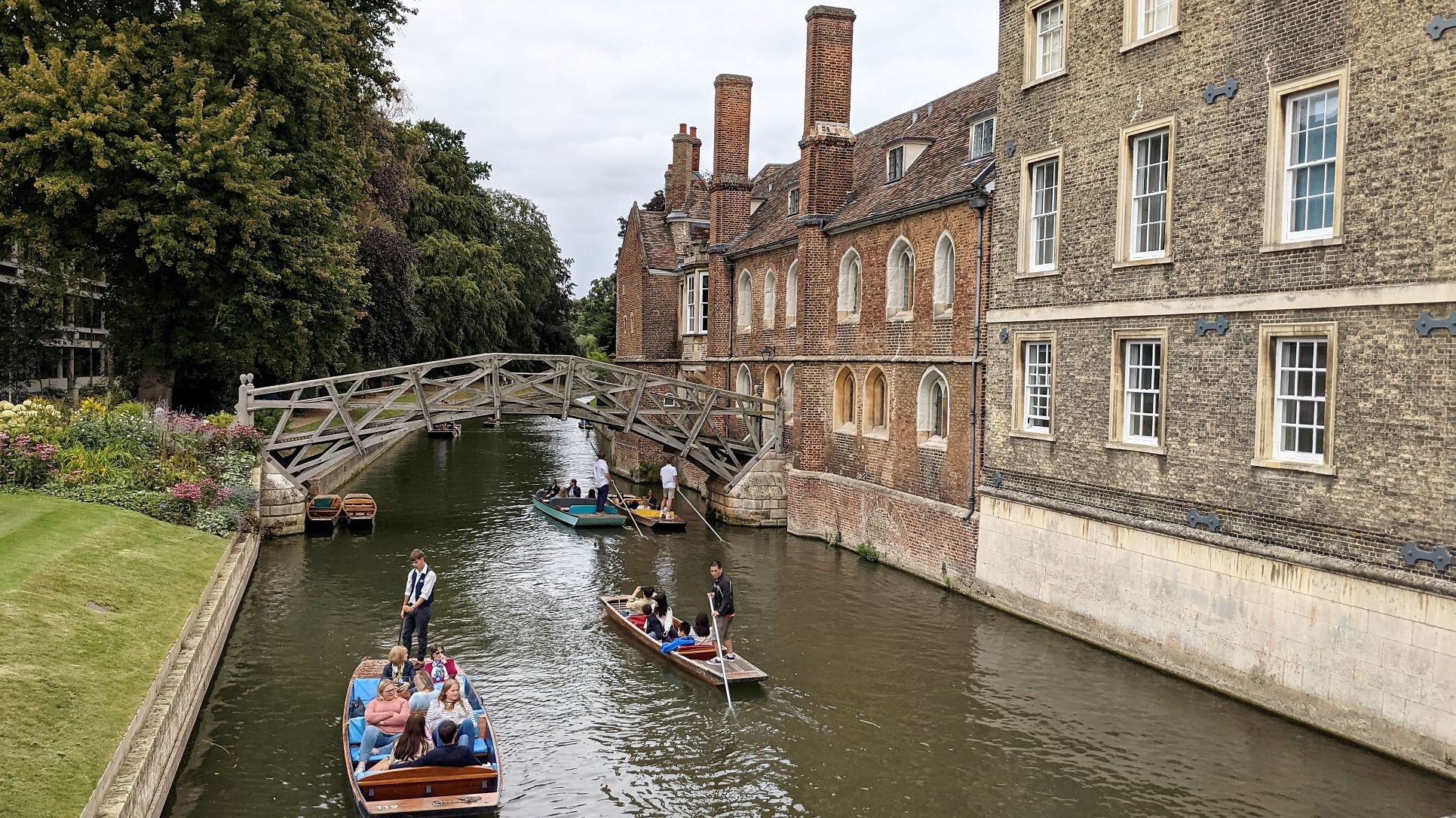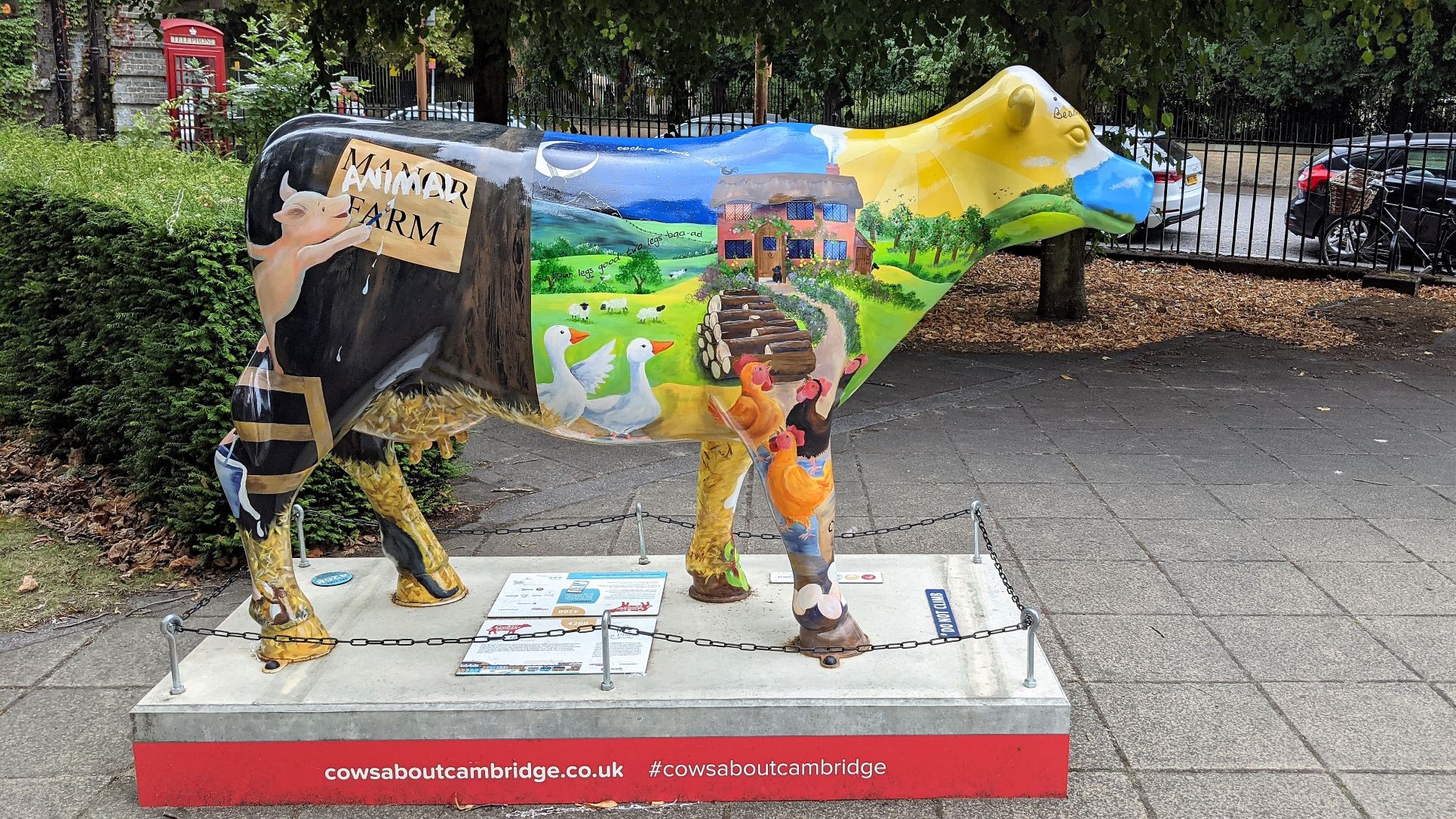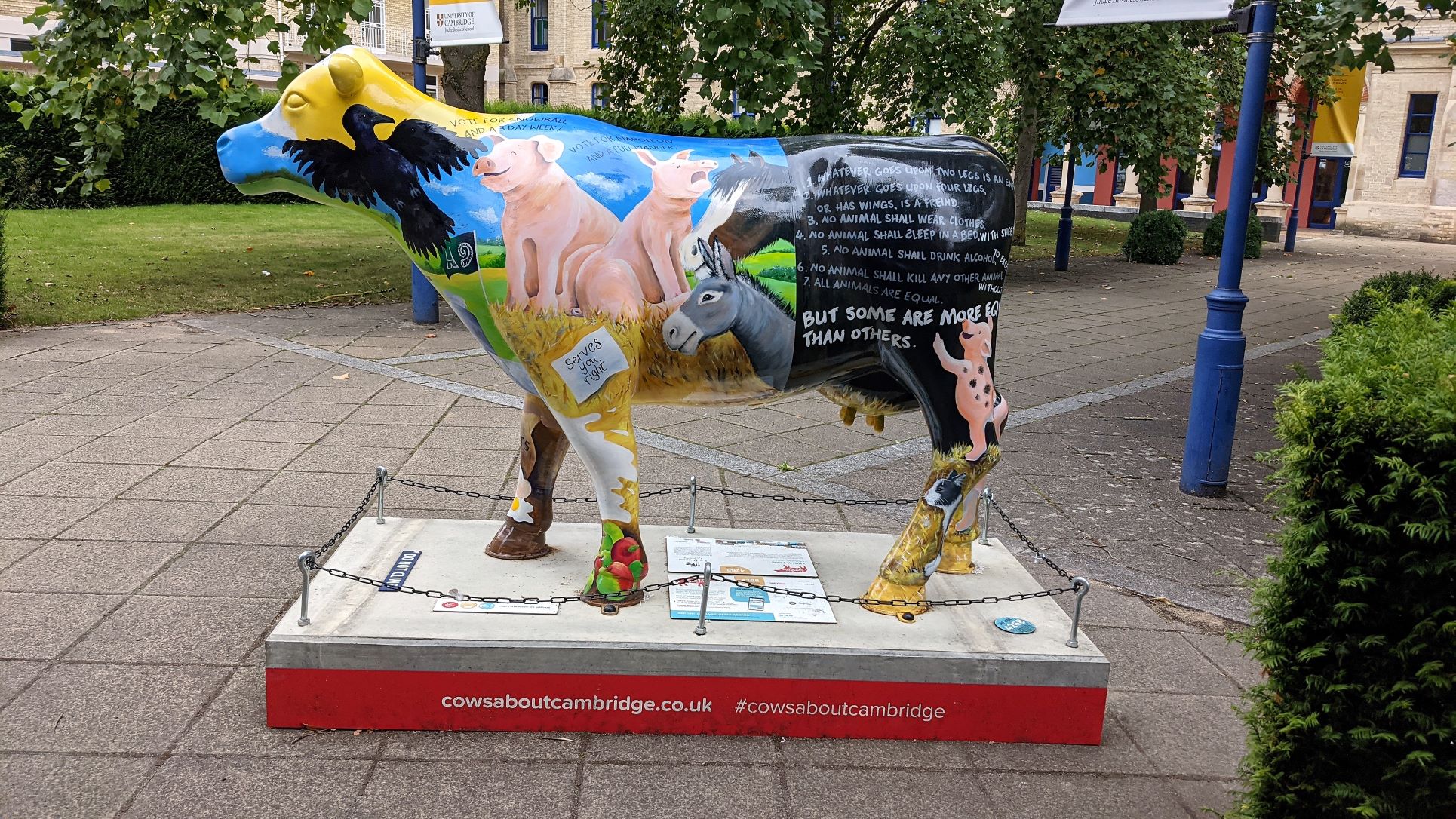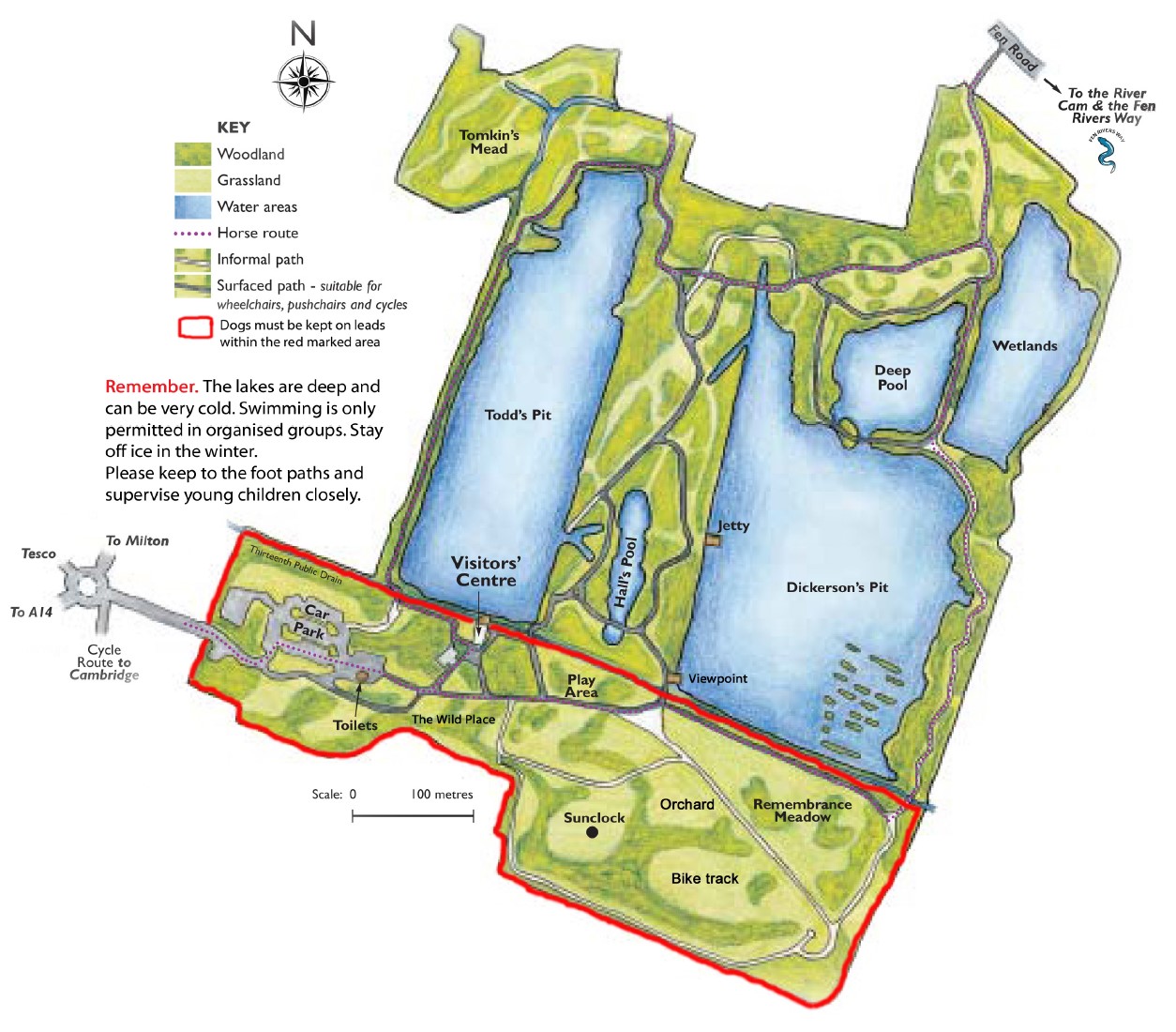East On The Old West
Leaving Holywell on Sunday morning it was a cool, grey morning but mostly dry. Heading down to Brownshill Lock I had read that "The favourite section of the river to spot [seals] is the Great Ouse between Brownhill's Staunch and Hermitage Lock because they come straight from the tidal river up the New Bedford River". Presumably they are not deterred, as we were, by the arrow-straight, twenty mile monotony of the New Bedford stretch and the reported extensive shoals. Normally, reading such statements in a guide book is a guarantee that there will be nothing to see here. Nevertheless, as the lock was emptying and Sue disappeared into its depths, I glanced over into the turbulent waters below the weir and immediately saw a seal playing in the fierce current. It seemed very aware of when a camera was pointing at it and took pains to submerge immediately but I managed to get a little bit of video and a few snaps before we moved on.
We stopped off at Westview marina, who were as helpful, welcoming and friendly as before. I couldn't resist having a browse in the surprisingly extensive chandlery inside their small offices. Lo and behold they had just one five litre container of Beta Marine engine oil. This was the only missing item preventing me from undertaking the next engine service, now some fifty engine hours overdue. Of course, I snapped it up, despite a slight regret that there could now be no more excuses.
As on the way upstream, our call to the lockkeeper at Hermitage Lock went unanswered but was acknowledged by the light turning to green as we approached, so we were able to go straight in and through the other side in ten minutes flat.
We had decided to moor again on the GOBA site at Aldreth. It had stayed dry most of the morning but as we left the lock, a large black cloud was chasing us down the river and chose to dump on us, in spectacular fashion, five minutes before we reached the mooring. Having tied up in the rain and taken shelter inside we had some lunch and emerged into brilliant sunshine that lasted the rest of the afternoon.
Having exhausted things to see on this side of the river last time we were here, I wandered up to High Bridge, about five hundred yards downstream, to walk along the opposite bank. Up by High Bridge, itself, I found an interesting information board relating to the days when Ely truly was an island and the only way to reach it was by river or across one of three causeways: Stultney, Earith and Aldreth.
The Aldreth causeway is considered the earliest and most important of these, despite the nondescript nature of Aldreth today. The route has probably been an ancient trackway since the Bronze Age but the local wisdom is that the causeway, itself, was first built by William The Conqueror or William The Bastard as he was known in his lifetime. It was part of his attempts to capture Hereward The Wake and disperse the Saxon army, who were waging a very successful guerrilla campaign against him, using their local knowledge of ancient tracks and pathways through the fenland. Things didn't go well for William. His first attempt foundered as the causeway sank under the weight of his troops, leaving many of them to drown. The second attempt, this time carrying a local witch aloft in their midst to curse the isle and its defenders, failed when the Saxons set fire to the reeds surrounding the causeway. The Norman attackers were overwhelmed with heat and smoke. Pursued by the arrows of the hidden defenders they attempted to flee through the marshes where, once again, many of them drowned. In the end, as is so often the case, it was treachery, rather than superior military prowess, that brought Hereward's army down. The Abbot and Monks of Ely chose to side with William and led his men through the treacherous wetlands and onto the dry ground of the island, although Hereward, himself, escaped.
This side of the river seemed largely unpopulated with the high bank protecting the land behind so I didn't expect to find much else of interest. However, there were some buildings in the distance so I carried on past a point opposite our boat and was confronted with this unexpected sign.
Sure enough, half a mile or so from the bridge, was Queenholme Alpacas, with a couple of dozen of these beasts, of various ages, grazing happily in the sunshine.
A long way from South America but there do seem to be more and more places in Britain keeping Llamas and Alpacas. It seems that, as the fleece of the Alpaca is a rare commodity, taken from an animal with a relatively slow breeding rate, only a small proportion of the global demand for the fibre is being met. Here in Britain they seem to be popular leisure attractions in a number of ways and the main business focus is actually on improving the bloodstock and breeding them for sale. For some reason, in this country, we don't seem to eat the meat from the Alpaca. Perhaps they are too valuable? Their meat is supposed to be tasty and nutritious. It is routinely eaten in its native land and I gather the meat is also on sale in Australia, although that may not be surprising.
Pope's Corner
We had a sunny start to Monday morning but with the cold north wind freshening steadily and blowing some clouds in as we went. The morning was made all the finer by the exceptional range of wildlife that put in an appearance. Obviously, we often enjoy seeing birds on our travels but we aren't exactly avid ornithologists. On this stretch, however, we turned into positive twitchers for the day, as every kind of bird we could think of came out to play. We spotted a Kestrel, Kingfishers, Egrets, Heron, Crested Grebes, Woodpeckers, Cormorants, Swans, Moorhens & Coots and those are just the ones we could identify. Better still, there were almost no Canada Geese.
The cruising was straightforward and we tied up on the EA mooring just short of the Fish & Duck Marina at Pope's Corner, where the River Cam runs off to the right and a left turn heads back down to Ely. While checking through the weed hatch for any signs of fouling on the propeller, I suddenly noticed that one of the blades on our propeller was bent at the tip. We thought about it and couldn't remember any significant grounding or strike that might have caused it recently nor had either of us noticed any real increase in vibration or change in handling over the last few days. We realised then that it could have happened at any time, weeks or even months ago, since we had more or less never seen the propeller before. Most of the work of clearing any fouling is done entirely by feel, since it is unusual for the water to be clear enough to see anything but a murky brown soup. On any rare occasion that it had been as clear as it was here, the specific blade in question would have to have been the one pointing upward to be able to be seen at all. To be on the safe side I contacted a local engineer recommended by the nearby Marina. Everyone in this line seems to be totally rammed with work at the moment and it was clear that no-one was going to be able come out any time soon. Having described the problem, however, he pointed out that it would be difficult to sort out with the boat in the water. As long as it wasn't causing excessive vibration and we still had plenty of thrust, it probably wasn't doing any serious harm or going to get worse. Our best bet would be to leave it and get it sorted out next time we had the boat out of the water for other reasons.
By now we were back to the wide dykes, high banks and completely flat, windswept countryside of the fenland drainage system. The sun had returned, although the wind persisted, keeping the temperature down. Reassured about the propeller, we decided to go for a walk up to and round the corner and back via a couple of villages on the Ely side, Little Thetford and Stretham.
The former was quite pretty with some interesting buildings but Stretham, while it seemed bigger and even had a pub, felt very dull. It did have an old windmill just outside but now privately owned and difficult to photograph.
It was quite a nice walk in the afternoon but by teatime the northeast breeze was really cooling things off. While we were away another boat had joined us and hung their washing out at the far end of the mooring so at least that should have dried well.
It was cold overnight with heavy condensation over the boat by morning, disappointing for mid-August it must be said. Nevertheless the sun was shining and things gradually warmed up with a bit less wind than the day before. We still felt it was rather ambitious of our neighbour to get the deckchair out at eight-thirty and settle down for a spell of topless sunbathing!
Our guide warned us that there is no fuel available on The Cam and services of any kind are very limited so we aimed to stop at the Fish & Duck Marina, whose service dock was on the river bank, just before the corner less than five minutes away. We arrived there but had to breast up against another narrowboat moored just behind the dock as it was occupied by a couple of small day boats. There was just one guy involved in managing the marina, operating the wharf and administering the hire business. It looked as though three groups of people had arrived to take over their hire boats for the day just as we turned up, so he was in for a busy time. In the end, we waited about forty-five minutes before he had cleared the wharf and we could move up to take on fuel but it wasn't a problem really. The boat we moored alongside wasn't occupied and we were able to deal with some of the other services, stepping across her stern and then enjoy a cup of coffee while we were waiting.
Clayhithe
As we were heading for Cambridge we hoped to meet up with Sue's sister and her husband who live close to the city. Initially, we thought we would arrange to meet in Cambridge itself. In the end, we fixed on The Bridge, a Chef & Brewer pub below the bridge at Clayhithe and about three hundred yards from the public mooring there.
Once we left the Fish & Duck, we took a sharp right onto The Cam and slowly the landscape began to get more varied, although the river remained quite wide at this point. We seemed to make better time than expected and it was only a couple of hours to get to Clayhithe. On the way we passed a pub at Upware called Five Miles From Anywhere (No Hurry). When you are cruising past, this certainly looks a credible claim but I couldn't resist putting it to the test. Sadly, a five mile radius from the pub includes at least four fairly substantial settlements at Soham, Stretham, Waterbeach and Burwell, so it doesn't quite stack up.
Three or four miles further on we came to Bottisham Lock. The lock is fully automated at both ends, so little physical effort, other than some wear and tear on the button thumb. However, this is the point where the EA relinquishes control and you are transferred into the care of the Cam Conservators. The lack of a reciprocal licensing arrangement with the Conservators or any short term visitor fee, is the sole reason that, in June 2021, we had had to buy a one year Anglian Pass, which has a fixed term that expires in March 2022, for one hundred English pounds.
The lock is only about a mile short of Clayhithe bridge and we soon arrived there to find a selection of anglers and magnet fishers cluttering the mooring, with the available space further restricted by a couple of 'git gaps' left by the boats already moored there. We managed to pull in just under the bridge, which is not an ideal setting but allowed us to watch the movements as the afternoon unfolded. One by one, the various danglers folded their tents and quietly stole away, people returned to their boats and moved off and we gradually moved our way up.
There isn't much more than the pub by the river at Clayhithe. On the opposite bank there is the Cam Conservators House. This is rather grand, Grade II listed, Victorian building that used to be the toll house and their offices. It seems to have been refurbished recently but I couldn't see what it is now, although it is still where they moor their weed boats.
There is no path along this far bank but I followed the road down towards the next crossing at Baits Bite Lock. The route passes through Horningsea on the way, a small village, a few hundred yards from the river, with a couple of pubs and the obligatory church.
There is plenty of private mooring along the bank at the north end of the village but nowhere available for public mooring. There is a GOBA site on the left bank almost opposite the village but with no way to get across it is quite a long walk to get there. The Haling Way, which apparently means 'towpath', runs all the way along the left bank back to The Bridge and is quite a pleasant walk but seemed very busy with both walkers and cyclists, a clear sign that we were getting close to a heavily populated and relatively affluent area.
After quite a fine, sunny day on Tuesday, Wednesday morning was cool and grey. Rain starting while we were finishing breakfast forced me to abandon my plan to wash the starboard side of the boat and sent me down into the engine bay to do the overdue service instead. Taking it slow and steady this was accomplished with only the expected amount of swearing and rather less spillage than on previous occasions. A great success and I was less than fifteen minutes late for lunch with Sue's sister at The Bridge.
Although there is nothing much to see at Clayhithe by the river it is a short walk into Waterbeach, quite a big village a little way inland and across the Cambridge to Ely railway line. With several pubs, a number of shops, a church and a station it is quite the metropolis. Before dinner I walked down the river to Bottisham Lock and back round via Waterbeach. Given the infrequency of the timetable it was a little irritating to be caught at the level crossing going in and very much so to then be stopped at the next one on my way out.
At the north end Waterbeach are the usual housing estates, gradually spreading out but as you get further down to the south end, nearer the river, it opens out and has a proper village feel. Combined with many more amenities than most settlements in the area it must make it a very popular place to live.
Up To The Backs
The following day was again grey and cool with a fresher breeze. Not terrible weather by any means but continuing the theme of being nothing like August. We set off in the morning and almost immediately "Cueetoo", a cruiser moored just behind us pulled away as well. They were always going to be faster than us so we slowed right down to let them pass, happy that this meant they could get the next lock ready for us to go straight in.
Baits Bite Lock is the last one on the Cam before Jesus Lock, where the services and a forty-eight hour visitor mooring opposite them was as far as we would be able to go. There is quite a lot of emphasis on enforcement of licensing and the ban on stopping anywhere that is not specifically signed as public mooring. Nevertheless, long stretches of the run into Cambridge are lined with moorings for long-term permit holders. Many of the boats moored here seem to be in as rough a condition as they are on the canals, forming little shanty towns and isolated sheds.
It is only about three miles or an hour's cruising to get up this stretch so we arrived at Jesus Lock by lunchtime and were surprised to find that the mooring was completely empty.
Jesus Lock is navigable but during the summer months The Backs are so thick with punts and rowers of all descriptions that no powered craft are permitted to proceed beyond Jesus Lock at all. From October to March, provided you have obtained permission from the Conservators in advance, it is possible to navigate all the way through The Backs to the The Mill pub, which is the head of the navigation.
The weir here prevents any further progress other than for craft small enough to carry round it by hand or for punts, which were dragged across on rollers. However, there no services on this section, there is nowhere at all to moor and no stopping is allowed so you can only go straight up and back and you are probably better off doing it by punt.
Beyond the weir, as it heads up to Grantchester in time for tea, the river is sometimes still called the Granta, which was its original name. Unusually, only after the market town of Granta Brygge had evolved to become known Cambridge was the name of the river then retrofitted to become the Cam.
The visitor mooring is across the river from Jesus Green, itself, below a busy main road. Seeing someone already fast asleep on one of the benches beside the moorings did make us wonder how it would be there overnight but we didn't experience any trouble or interference. It is well placed to explore the city. Crossing the bridge by the lock, it is a short walk across Jesus Green to emerge from a narrow little lane into Bridge Street, which is on the edge of the tourist centre and crammed with visitors. While Sue located the laundrette I went in to the centre to see what guidance I could get from the Tourist Information Centre. Not much, it turned out, as the Cambridge Visitor Information Centre is permanently closed! Having had a look round I returned to the boat and went online to find a self-guided walking trail we could follow the next day.
With only two nights to stay here we needed to cram a lot in on Friday. We hadn't visited a supermarket since Ely, Sue was in dire need of some retail therapy and we wanted to see some of the historic centre. The walk we downloaded turned out to be ideal, covering a lot of ground with just enough detail and conveniently taking us through the Market Square at lunchtime. The market is here everyday and has stalls offering every kind of street food. We could sit outside and share a massive pork & chicken wrap that turned out to taste as good as it smelt.
The city was very busy, full of tourists and with a higher proportion of foreign visitors than, perhaps, we had expected after the global lockdown. A feature we well remembered from past visits was the mass of bicycles swooping through the crowds, silent but potentially deadly, impatient with the pedestrian obstructions but somehow managing to navigate through them without incident. If it was busy now it must be a nightmare when all the students are back up for the Michaelmas Term.
At Magdalene Bridge and Silver Street Bridge you have to negotiate the punt stations, where a great many students who have hung around for the summer seem to be employed. In between crewing the punts and other craft for hire, they are put to work vying with one another to attract the attention of any passer-by and inveigle them into paying for a trip on the river. We took great pleasure in being able to tell them we didn't need it, as we were living on a boat.
We enjoyed the tour and there are so many impressive buildings and intriguing stories. At one time you were able to visit the colleges and walk through some areas but now they all have signs outside saying that the due to the virus they are closed to outside visitors. You have to wonder whether, having recovered their privacy, they will ever open up in the same way again. For now, at least, you have to be content with the view from the street or peering at the magnificent views of the college Backs from the footpath alongside Queen's Road.
As we followed the tour we came into Trumpington Street by the old Addenbrookes Hospital site. The NHS has long since decamped to a modern campus outside the city centre and the site is now the Judge Business School but the impressive façade has been well-preserved and refurbished. Outside the building there was a brightly coloured cow, standing just off the street.
On closer inspection it had a series of quotes and references to George Orwell's "Animal Farm" incorporated in the design.
After that we kept coming across more of these gaudy bovines and realised they were part of an art trail created across the city for the summer. You can read more about it here: Art Trail - Cows about Cambridge 2021 : Cows about Cambridge 2021
In the evening we strolled along Quayside up to Magdalene Bridge and dined at a a steak house in Bridge Street. The city was bustling and loud with people out to enjoy themselves for the evening at the start of the Bank Holiday weekend. Every restaurant, pub and bar we passed was packed, with crowds spilling onto the street and enjoying a mild, if rather grey, summer evening. It all seemed like a refreshing return to normality after the previous year or so.
Up To The Backs
The following day was again grey and cool with a fresher breeze. Not terrible weather by any means but continuing the theme of being nothing like August. We set off in the morning and almost immediately "Cueetoo", a cruiser moored just behind us pulled away as well. They were always going to be faster than us so we slowed right down to let them pass, happy that this meant they could get the next lock ready for us to go straight in.
Baits Bite Lock is the last one on the Cam before Jesus Lock, where the services and a forty-eight hour visitor mooring opposite them was as far as we would be able to go. There is quite a lot of emphasis on enforcement of licensing and the ban on stopping anywhere that is not specifically signed as public mooring. Nevertheless, long stretches of the run into Cambridge are lined with moorings for long-term permit holders. Many of the boats moored here seem to be in as rough a condition as they are on the canals, forming little shanty towns and isolated sheds.
It is only about three miles or an hour's cruising to get up this stretch so we arrived at Jesus Lock by lunchtime and were surprised to find that the mooring was completely empty.
Jesus Lock is navigable but during the summer months The Backs are so thick with punts and rowers of all descriptions that no powered craft are permitted to proceed beyond Jesus Lock at all. From October to March, provided you have obtained permission from the Conservators in advance, it is possible to navigate all the way through The Backs to the The Mill pub, which is the head of the navigation.
The weir here prevents any further progress other than for craft small enough to carry round it by hand or for punts, which were dragged across on rollers. However, there no services on this section, there is nowhere at all to moor and no stopping is allowed so you can only go straight up and back and you are probably better off doing it by punt.
Beyond the weir, as it heads up to Grantchester in time for tea, the river is sometimes still called the Granta, which was its original name. Unusually, only after the market town of Granta Brygge had evolved to become known Cambridge was the name of the river then retrofitted to become the Cam.
The visitor mooring is across the river from Jesus Green, itself, below a busy main road. Seeing someone already fast asleep on one of the benches beside the moorings did make us wonder how it would be there overnight but we didn't experience any trouble or interference. It is well placed to explore the city. Crossing the bridge by the lock, it is a short walk across Jesus Green to emerge from a narrow little lane into Bridge Street, which is on the edge of the tourist centre and crammed with visitors. While Sue located the laundrette I went in to the centre to see what guidance I could get from the Tourist Information Centre. Not much, it turned out, as the Cambridge Visitor Information Centre is permanently closed! Having had a look round I returned to the boat and went online to find a self-guided walking trail we could follow the next day.
With only two nights to stay here we needed to cram a lot in on Friday. We hadn't visited a supermarket since Ely, Sue was in dire need of some retail therapy and we wanted to see some of the historic centre. The walk we downloaded turned out to be ideal, covering a lot of ground with just enough detail and conveniently taking us through the Market Square at lunchtime. The market is here everyday and has stalls offering every kind of street food. We could sit outside and share a massive pork & chicken wrap that turned out to taste as good as it smelt.
The city was very busy, full of tourists and with a higher proportion of foreign visitors than, perhaps, we had expected after the global lockdown. A feature we well remembered from past visits was the mass of bicycles swooping through the crowds, silent but potentially deadly, impatient with the pedestrian obstructions but somehow managing to navigate through them without incident. If it was busy now it must be a nightmare when all the students are back up for the Michaelmas Term.
At Magdalene Bridge and Silver Street Bridge you have to negotiate the punt stations, where a great many students who have hung around for the summer seem to be employed. In between crewing the punts and other craft for hire, they are put to work vying with one another to attract the attention of any passer-by and inveigle them into paying for a trip on the river. We took great pleasure in being able to tell them we didn't need it, as we were living on a boat.
We enjoyed the tour and there are so many impressive buildings and intriguing stories. At one time you were able to visit the colleges and walk through some areas but now they all have signs outside saying that the due to the virus they are closed to outside visitors. You have to wonder whether, having recovered their privacy, they will ever open up in the same way again. For now, at least, you have to be content with the view from the street or peering at the magnificent views of the college Backs from the footpath alongside Queen's Road.
As we followed the tour we came into Trumpington Street by the old Addenbrookes Hospital site. The NHS has long since decamped to a modern campus outside the city centre and the site is now the Judge Business School but the impressive façade has been well-preserved and refurbished. Outside the building there was a brightly coloured cow, standing just off the street.
On closer inspection it had a series of quotes and references to George Orwell's "Animal Farm" incorporated in the design.
After that we kept coming across more of these gaudy bovines and realised they were part of an art trail created across the city for the summer. You can read more about it here: Art Trail - Cows about Cambridge 2021 : Cows about Cambridge 2021
In the evening we strolled along Quayside up to Magdalene Bridge and dined at a a steak house in Bridge Street. The city was bustling and loud with people out to enjoy themselves for the evening at the start of the Bank Holiday weekend. Every restaurant, pub and bar we passed was packed, with crowds spilling onto the street and enjoying a mild, if rather grey, summer evening. It all seemed like a refreshing return to normality after the previous year or so.
Back Past Baits Bite
On Saturday our time was up, so we had to leave. The river was busy with Saturday morning rowers and we watched a pair of boats, whose crews were clearly novices in training, come up to the lock and try to turn. The boats are a lot slimmer and lighter than ours but it was interesting to see that they are not much more manoeuvrable. They seem to be about the same length as us and with oars out on both sides they are almost as wide as they are long. Getting several human brains to interpret one instruction identically and all work in unison to execute it was clearly as difficult as I have come to expect so there was quite a bit of entertaining thrashing about before they had finally made it round and headed back down.
In the meantime, "New Moon" had suddenly appeared behind them and moored up at the service point we needed to use, opposite the mooring. As always, timing is everything in this game. We started to move across to wait and realised that it was our turn to get our act together. As we went to pull in and tie up to the bank we realised that the bow doors were locked so Sue couldn't get in that end, the centre lines we rely on to hold the boat were out of reach and the stern line was in a complete tangle, we really should be better at this by now. We got onto the water point in the end and were finally on our way by about eleven thirty. We were in no hurry, however, as we had arranged to meet friends in Ely and had agreed to wait until the day after the Bank Holiday, given that Ely was likely to be very busy over the weekend. As a result, we were only planning to go as far as the GOBA mooring opposite Horningsea about one and a half hours downstream.
Above Baits Bite Lock is the area most congested with college rowing and the Head races and Bumps are organised on this stretch. On the way down, we passed back through signs warning you to keep left, instead of keeping right as is the rule everywhere else, as well as to give priority to craft travelling upstream, rather than those going down. Apparently this is known as the 'Gut' and the change in priorities is because the unmaneuverability of a sixty foot rowing eight, which we had observed before setting out, manifests itself to the full on this narrow winding section.
August was continuing the theme of being grey, dull, windy and occasionally a bit damp, going out as it came in really. Having moored up at Horningsea and had lunch, another boat pulled up behind us. This turned out to be "New Moon" but the crew were wholly unfamiliar. It seems that this is a private hire boat and the couple we had chatted to on the service point at Jesus Green must have been the owners, getting it prepared for the new hirers. I gave them a hand to tie up and they were clearly new to the game. Sensibly, having picked the boat up, they had decided to moor up and get used to the boat before going any further.
Up by the lock, a road heads west and across the railway to an entrance into Milton Country Park. I walked up there and had a good look round. There are some large pools with paths through them and plenty of wildlife and there is a visitor centre, café and car park but I am afraid it is best described as Stanwick Lakes on Mogadon.
It feels quite small and cramped and apart from the route in by road to the car park there no way in or out except the one access point I had arrived through, on the other side of the park. Overall, a bit disappointing.

